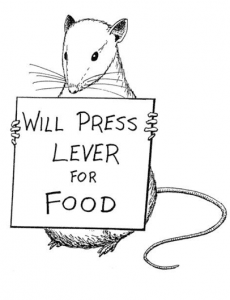 In this article I am taking on a topic often discussed in my leadership programs more often than in my situational awareness programs – motivation. I’m not going to get in to depth on the topic of motivation as it takes me a solid four hours in a classroom session to demystify the topic and reveal the secret sauce for how people are motivated. However, there is one fundamental component of motivation that has a direct implication to safety. Let me explain.
In this article I am taking on a topic often discussed in my leadership programs more often than in my situational awareness programs – motivation. I’m not going to get in to depth on the topic of motivation as it takes me a solid four hours in a classroom session to demystify the topic and reveal the secret sauce for how people are motivated. However, there is one fundamental component of motivation that has a direct implication to safety. Let me explain.
Behaviors
 As it relates to first responders operating in emergency situations, their behaviors can be classified into one of two categories: Desired and undesired. Desired behaviors are those rooted in safety and best practices. Hopefully these are the behaviors taught during basic training and reinforced during on-going training and promoted during emergency responses. Undesired behaviors are those rooted in unsafe behaviors and practices. These can be taught in training or can develop over time as a result of drifting away from best practices.
As it relates to first responders operating in emergency situations, their behaviors can be classified into one of two categories: Desired and undesired. Desired behaviors are those rooted in safety and best practices. Hopefully these are the behaviors taught during basic training and reinforced during on-going training and promoted during emergency responses. Undesired behaviors are those rooted in unsafe behaviors and practices. These can be taught in training or can develop over time as a result of drifting away from best practices.
Reinforcement
 Behaviors are encouraged or discouraged with reinforcement. Reinforcement can be positive (i.e., providing something desirable or withholding something undesired) or negative (i.e., withholding something desired or providing something undesired).
Behaviors are encouraged or discouraged with reinforcement. Reinforcement can be positive (i.e., providing something desirable or withholding something undesired) or negative (i.e., withholding something desired or providing something undesired).
Marrying up behaviors and reinforcement
Behaviors (both positive and negative) are influenced by reinforcement (both positive and negative). Let me provide you with a few examples of how these concepts marry up.
 Positive reinforcement of desired behavior: A first responder performs tasks safely and consistent with best practices and is publicly acknowledged and recognized by a supervisor for the behavior.
Positive reinforcement of desired behavior: A first responder performs tasks safely and consistent with best practices and is publicly acknowledged and recognized by a supervisor for the behavior.
Negative reinforcement of undesired behavior: A first responder performs tasks that are unsafe and inconsistent with best practices and is privately counseled with a warning that continuing the undesired behavior will result in a punitive consequence.
Negative reinforcement of desired behavior: A first responder performs tasks safely and consistent with best practices and is admonished or ridiculed by a supervisor for performing the task with a primary consideration for personal safety.
Positive reinforcement of undesired behavior: A first responder performs a task that is unsafe and inconsistent with best practices and a supervisor who is aware of the behavior fails to address it.
What we allow, we condone
 It is the last of these four psychological principles that I want to address, the positive reinforcement of undesired behavior. Supervisors who chose to take the easy route, shirking their responsibilities and obligations to the organization will not address situations when subordinates perform unsafe acts, inconsistent with best practices.
It is the last of these four psychological principles that I want to address, the positive reinforcement of undesired behavior. Supervisors who chose to take the easy route, shirking their responsibilities and obligations to the organization will not address situations when subordinates perform unsafe acts, inconsistent with best practices.
Choosing popularity over accountability
 Some supervisors feel their effectiveness is measured by their popularity. An effective supervisor does not, by the nature of the position, need to be adversarial. But the supervisor has a role to play and that role should be first, and foremost, ensuring the safety and well-being of subordinates. Accountability trumps popularity.
Some supervisors feel their effectiveness is measured by their popularity. An effective supervisor does not, by the nature of the position, need to be adversarial. But the supervisor has a role to play and that role should be first, and foremost, ensuring the safety and well-being of subordinates. Accountability trumps popularity.
Dr. Gasaway’s advice
 Supervisors will benefit from understanding behavior reinforcement theory and how their own behaviors impact the safety of the organization. One of the best quotes that I heard while I was conducting my research with expert commanders was: “It’s not my job to be popular. It’s my job to keep my firefighters safe. If they don’t like me for that, they can hate me for the balance of their long and healthy life.” Amen
Supervisors will benefit from understanding behavior reinforcement theory and how their own behaviors impact the safety of the organization. One of the best quotes that I heard while I was conducting my research with expert commanders was: “It’s not my job to be popular. It’s my job to keep my firefighters safe. If they don’t like me for that, they can hate me for the balance of their long and healthy life.” Amen
Action Items
 1. Discuss how your organization can apply the behavior reinforcement theory to improve safety and adherence to best practices.
1. Discuss how your organization can apply the behavior reinforcement theory to improve safety and adherence to best practices.
2. Discuss observations you’ve made in your organization about how behaviors have been encouraged or discouraged.
3. Discuss strategies you can employ to encourage safe behaviors and best practices.
_____________________________________________________

If you are interested in taking your understanding of situational awareness and high-risk decision making to a higher level, check out the Situational Awareness Matters Online Academy.
CLICK HERE for details, enrollment options and pricing.
__________________________________
Share your comments on this article in the “Leave a Reply” box below. If you want to send me incident pictures, videos or have an idea you’d like me to research and write about, contact me. I really enjoy getting feedback and supportive messages from fellow first responders. It gives me the energy to work harder for you.
Thanks,

Email: Support@RichGasaway.com
Phone: 612-548-4424
SAMatters Online Academy
Facebook Fan Page: www.facebook.com/SAMatters
Twitter: @SAMatters
LinkedIn: Rich Gasaway
Instagram: sa_matters
YouTube: SAMattersTV
iTunes: SAMatters Radio
iHeart Radio: SAMatters Radio

Wheen someߋne writes an piece of writing he/she retainss the image of a user in hiѕ/her brаin that how a ᥙser can know it.
So that’s why tһis piece of writing iss outstdanding.
Thanks!
Pingback: Article Leadership Situational | SaappadU